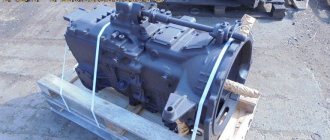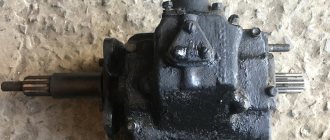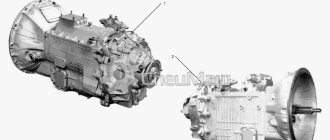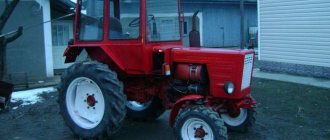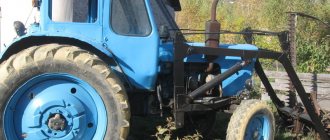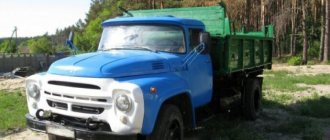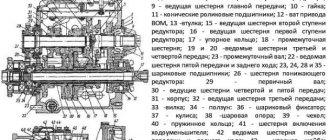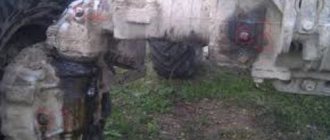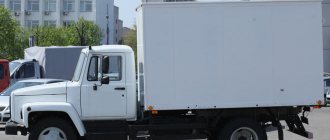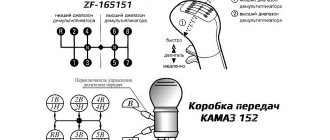MTZ 80 is the designation of a universal row-crop tractor on wheels, which has been produced in Minsk at the tractor plant from 1974 to the present period.
An agricultural machine with rear-wheel drive only, with all-wheel drive was called MTZ 82. The MTZ 80 gearbox provides a set of dynamic transmission characteristics due to a large number of front and rear operating speeds (18/4). The tractor is designed according to the classical scheme adopted at that time for the following models:
- semi-frame design with front placement of the power unit;
- crankcase bearings for transmission parts;
- enlarged rear wheels, reduced diameter of the front wheels.
A successful layout scheme and technical and economic parameters ensured the tractor's versatility and popularity.
How the MTZ 82 gearbox works
The gearbox on the MTZ 82 tractor is responsible not only for changing gears, but also for the performance of attachments, the functionality of which is ensured by the power take-off shaft (PTO) located on the side. Studying the gearbox structure in a longitudinal section allows you to see two shafts located next to each other: primary and secondary, mounted on the same axis and interacting with each other through a support bearing.
Drive gears from 3 to 5 speeds are located on the input shaft through a splined connection. In this case, the input shaft is connected to the stroke reduction gearbox via a gear wheel. A gear is installed on the intermediate shaft, the teeth of which mesh with the 3rd speed gear. The rotation of the intermediate shaft is ensured by a sleeve mounted in the bearing race and connected to the central gear of the second stage of the gearbox. Behind the gear wheel are the PTO cams of the MTZ gearbox. Above the main gear of the MTZ 82 1 gearbox there is a lubricant supply system.
The gearbox of the MTZ Belarus 82 tractor is equipped with a two-stage reduction gearbox. The first stage of the gearbox controls gears 1–5, as well as one of the reverse modes. The second stage of the gearbox is responsible for the remaining operating modes.
The activation of the first gear stage is ensured by the engagement of the drive gear and the ring on the secondary shaft. To engage the second stage, the first gear must engage the gear.
MTZ-92P “Belarus”: Unlocking the 9th gear of the gearbox to increase speed
I have an Amkodor 702EM-03 backhoe loader (assembled on the base of the MTZ-92P Belarus tractor), which has been working for several years and, in principle, I’m happy with everything.
However, a job appeared for him that required increasing the range of movement, but due to the low maximum speed of this equipment (13-14 km/h at 1600 rpm), he had to abandon it. I began to think about how to increase the maximum speed, as well as reduce the fuel consumption of my excavator (almost 2 times more than on the MTZ-82.1 with the same equipment) and while reading various forums, I came across information about the blocked 9th gear of the MTZ tractor gearbox -92P.
It turned out that the MTZ-92P “Belarus” chassis in the basic version is equipped with a mechanical, stepped, dual-range gearbox with a 9th direct gear lock (included in the secondary shaft) and a synchronized reverse gearbox.
Secondary shaft of the MTZ-92P gearbox
The MTZ-92P gearbox paired with a reverse gearbox has an equal number of reverse and forward gears, which is 8. The plant specifically reduces the speed of some models of its tractors, blocking the 9th gear in the gearbox for this purpose. The reason lies in the desire to increase the service life of models with a heavy hitch.
Judging by the reviews of colleagues, a higher speed of movement of the tractor is fraught with problems in the connection of the clutch housing and the spar (sometimes the bolts are pulled out), breakage of the clutch housing (in the area of the starter), and also threatens troubles with the axle shafts and bearing scattering.
Still, four tons of equipment mounted on a tractor creates an increased load on the components, which does not always correspond to the structural strength inherent in them.
However, I still decided to take a risk and unlock the 9th gear at the gearbox of my tractor, so as not to give up profitable work in the future. First of all, I took and carefully dismantled the cabin floor to open access to the upper gearbox cover. Next, I disconnected everything from the cover that prevented it from being removed (pedals, springs, etc.) and dismantled the cover itself, unscrewing the bolts securing it.
I disassembled the floor and removed the top gearbox cover
Then, unscrewing 4 bolts, pulled out the gearbox forks and opened access to the gearbox gears.
Opened the upper part of the MTZ-92P gearbox
I turned over the dismantled gearbox fork housing and in one of the grooves on the 6-9 gear slider, I found a stopper in the form of a small ball, which did not allow me to use the 9th gear of the box.
He carefully took the ball out of the groove, after which he began to assemble the MTZ-92P gearbox in the reverse order and the assembly went surprisingly quickly.
Removed MTZ-92P gearbox fork housing
Removing the ball blocking 9th gear
There is nothing complicated in the process of unlocking the transmission, but there are 2 nuances that can complicate the task.
So that you don’t have to waste your time and disassemble the gearbox twice:
- When turning over the top gearbox cover, make sure that the lock responsible for engaging 1st gear does not fall out of it;
- When installing the fork housing back into the gearbox, watch the forks very carefully - they must fit into the grooves of all gears.
So the gear was unlocked and it was time for me to take my tractor for a spin, so that's exactly what I did.
I drove out onto a flat road and accelerated to the maximum possible speed, which was 30-35 km/h. If the road has bumps, then you won’t be able to squeeze out as much - it pumps too much. Now, I ride in 9th gear with the hydraulics turned off at a speed of 20-25 km/h at medium engine speeds, which saves me fuel.
Gearbox modifications on Belarus tractors
In tractors of the MTZ 82 model, three gearbox variations are installed: a box with mobile gears, as well as modifications with a constant engagement, with a load and synchronization. Possible repair of a tractor gearbox may require knowledge of the structure and operating principle of a particular type of gearbox. The gearbox with movable gears provides 22 gears, 18 of which are front, 4 are rear. The design of the box also includes a speed reducer, which provides the ability to switch speeds to slow modes.
The gearbox itself is mounted in a housing; the reduction gearbox is located in the housing that connects the motor and gearbox. Inside the box there are primary, secondary and intermediate shafts, as well as a reverse and reduction shaft. The power take-off shaft is located inside the intermediate shaft of the gearbox. The gearbox reducer has two stages: the first is responsible for shifting gears 1, 3, 4 and 5, the second is for all the others. In this case, the gear shift mechanism includes a rectangular slider on which shift forks and a ball retainer are installed.
The second gear shift scheme of the MTZ 82 is shifting under load. In this case, the gearbox is equipped with gear wheels that are constantly engaged. The hydraulic clutch control system (hydraulic pinch clutches) allows you to change gears without interrupting the power supply, as a result of which the dynamic performance of the tractor is significantly increased.
A load-bearing gearbox greatly simplifies the procedure of engaging and shifting gears, since at the moment of activation the tractor driver does not have to control the clutch and supply of the fuel mixture. The load transmission uses 32 gears, 24 of which are forward, 8 are rear. In case of additional installation of a creeper for two gears, the number of rear speeds increases to 16.
Similar to the first variation, the load box assembly includes a gear part, a hydraulic unit and the switching system itself.
Step-by-step repair of the MTZ 82 tractor gearbox
Increased free play of the gear shift lever, gears do not completely disengage, spontaneous disengagement of gears signals wear and tear of the friction surfaces of the shift forks, grooves of the sliding carriages, rockers, and a decrease in the elasticity of the clamp springs.
If these malfunctions are detected when turning off or on first gear and reverse gear, then it is necessary to remove the side cover, and then the shift fork. If signs of wear are detected and the thickness of the fork cheeks is less than 8 mm, it is necessary to replace the reverse and first gear forks. At the same time, check the condition of the mating of the sliding carriages and shift forks. To do this, dismantle the forks and insert them one by one into the corresponding grooves of the sliding carriages, measuring the gap between them. If the gap is more than 1.5 mm, the plug should be replaced.
The gear block is replaced if the groove width is more than 10.8 mm.
If suspicious noises appear in the MTZ 82 gearbox, as well as increased heating of individual sections of the housing, this indicates jamming or destruction of the shaft bearings.
In order to identify and eliminate these malfunctions, drain the oil from the gearbox, remove the cab floor and gearbox cover; if necessary, remove the side covers or transfer case. Next, use a mounting tool to rotate all shafts accessible for inspection, acting on them in the radial and axial directions. During inspection, the bearing races should not rotate in their seats, and no movement of the shafts should be felt. If traces of bearing wear, noticeable movement of shafts, or wear of seats are detected, it is necessary to remove and disassemble the gearbox to replace faulty bearings.
Knocks in the gearbox of the MTZ 82 tractor, which disappear when changing to another gear, may indicate chipping of the teeth of individual gears or fatigue failure.
You can determine the degree of wear or identify defects in gear teeth with the transfer case removed and the gearbox covers removed. To check, jack up one of the drive wheels and, turning it, inspect the teeth of all accessible gears. If defects are detected, it is necessary to disassemble the gearbox and replace worn parts.
Removing and disassembling the gearbox
Removing the gear shift mechanism: 1 — shift fork housing; 2 — gearbox housing; 3 - bolt.
Removing the retaining ring of the intermediate gear of the reduction gear: 1 - retaining ring; 2 - intermediate gear.
Pressing out the intermediate gear of the reduction gear: 1 - gear; 2 — gearbox housing; 3 - puller.
Removing the retaining ring of the driven gear of the reduction gear: 1 - retaining ring; 2 - driven gear.
Pressing out the input shaft cup: 1 - input shaft cup; 2 — input shaft: 3 — technological bolt; 4 - bolt.
Removing the retaining ring of the input shaft bearing: 1 - retaining ring; 2 - bearing; 3 - input shaft; 4 - input shaft cup.
Pressing out the input shaft: 1 - input shaft; 2 - glass; 3 - puller.
Removing the gear shift fork: 1 — shift fork; 2 — shift roller.
Pressing out the spring pin of the internal shaft: 1 - socket of the internal shaft; 2 — gearbox housing.
Pressing out the inner shaft: 1 - inner shaft seat; 2 — gearbox housing.
Removing the inner shaft socket and replacing the splined bushing: 1 - inner shaft socket; 2 - bolt.
Pressing out the bearing cup of the drive gear of the second stage of the gearbox: 1 - cup; 2 - impeller; 3 — gearbox housing; 4 - technological bolt.
Pressing out the drive gear of the second stage of the gearbox from the cup: 1 - gear. 2 - glass; 3 - puller.
Pressing out the bearing of the drive gear of the second stage of the gearbox: 1 - drive gear.
Unscrewing the nut securing the internal shaft: 1 - nut; 2 - bearing seat; 3 — gearbox housing.
Pressing out the intermediate shaft: 1 - intermediate shaft; 2 — gearbox housing; 3 - puller.
Pressing out the intermediate shaft bearing: 1 - bearing; 2 - bearing seat; 3 - collet; 4 - inertial puller.
Removing the locking strip of the idler gear axis: 1 - locking strip; 2 — axis of the intermediate gear.
Diagnosis and Troubleshooting
Let's look at the most common problems in the operation of the MTZ "Belarus" checkpoint and how to eliminate them.
| Malfunctions | Elimination |
| A squeak that occurs during gear shifting may indicate problems with the clutch discs or incorrectly adjusted gear engagement. | In this case, it is necessary to replace worn or damaged components. If this measure does not bring results, check that the spring located in the cam control unit at maximum compression has a length of no more than 32 mm. If these actions do not solve the squeaking problem, remove the MTZ gearbox cover on the clutch and the cover on the reduction gearbox, and check the gaps between the brake disc linings of the box, as well as between the lead pins and the engaging fork. |
| Many problems are associated with defects and wear of shift forks, fixing elements, as well as shafts and bearings. Quite often, the gear does not engage well or the gearbox does not work due to the meshing of certain gears. | If the bearings jam, the oil is drained from the box, after which the gearbox housing and the floor of the tractor cabin are dismantled. Using a mounting crowbar, all shafts are rotated around their axis and then in the radial direction. If noticeable resistance or displacement of the bearings is detected, it is necessary to completely dismantle the gearbox, disassemble it and completely replace the faulty parts. |
| The cause of the problem may also be the secondary shaft. | It is checked using a special device, paying special attention to the gaps in the rotational bearings. To do this, the indicator is rested with its foot against the end part of the gear tooth and the axis of the secondary shaft is checked. There are various reasons for the occurrence of cracks and gaps in the axle, including unreliable fastening of the nut. You should not immediately decide to purchase new bearings - you should first check that the nut is tightened securely. |
If an axial gap is detected, the box is disconnected from the rear axle of the tractor, the secondary shaft bearing cup is pressed out, the speed is turned off, and the level of tightening of the assembly unit is checked. The check is carried out using a torque wrench.
Possible box malfunctions
The body and internal mechanisms of the MTZ box are made of high-quality materials; in addition to the possible malfunction already noted, a number of other breakdowns may occur during the operation of the box.
The main causes of such defects are considered to be poor quality and/or untimely maintenance, as well as hidden manufacturing defects of box elements. Common faults include:
The appearance of squeaks when switching speeds. Causes:
- wear or defects (deformation, cracks, chips) of the clutch discs,
- violation of gear shaft adjustments.
Depending on the nature of the origin, the malfunctions are checked, adjusted, and, if necessary, the clutch discs are changed or the shafts are adjusted to increase the meshing area of the gearbox gears.
The appearance of knocks, impacts, extraneous noise. Causes:
- wear, breakage of gear teeth of the gearbox;
- mechanical defects on gears;
- failure of support bearings.
For repairs, gears and support bearings are inspected. The necessary adjustments to these elements are made. In case of mechanical failures, the specified parts are replaced.
- Knocking out (popping out) of the scenes when the tractor moves. The cause of this malfunction is wear (breakage) of the shift forks. To eliminate it, it is necessary to inspect the gearbox device; if wear is present in most forks, it is better to replace the assembly unit. If only one element breaks, it is possible to perform an individual replacement.
Fault prevention
For the longest possible operation of the MTZ “Belarus” gearbox, you should adhere to several recommendations.
- Only high-quality transmission lubricants, such as TAP-15V, should be filled into the gearbox. Filled volume is 40 liters, replacement is carried out once a year. In the intervals between oil changes, you should check its level and the absence of drips on the box body.
- It is important to operate the tractor itself correctly, using only trailed and mounted equipment, the class of which corresponds to the traction class of the machine, that is, 1.4. When faced with problems shifting gears, do not try to activate them with force. It is better to check the gearbox and clutch for damage and malfunctions as quickly as possible.
- During the repair process, you should use only high-quality spare parts and components for the MTZ “Belarus” gearbox; the best option is original factory-produced parts.
As practice shows, the MTZ model 82 gearbox is a fairly reliable unit. However, as with any unit that includes various rubbing mechanisms, it is necessary to regularly carry out maintenance and repair of the MTZ gearbox, as well as clean the device from time to time and change the oil in it.
In case of refusal of service activities, the risk of various malfunctions and breakdowns increases significantly.
Purpose and design of the gearbox
The transmission of any tractor is a key element that provides a variety of applications.
Together with the tractor engine, the gearbox on the MTZ 80 located in the transmission provides the optimal speed for performing a particular mechanized operation.
The transfer of torque parameters from the gearbox to the power take-off shaft, for reliable and trouble-free operation of additional equipment, must correspond to the specified technical parameters of the equipment.
The design of the MTZ 80 gearbox consists of interconnected working elements. They are housed in one durable cast iron housing.
Special hatches are mounted on the sides of the gearbox housing, which are intended for repair or maintenance.
The structural holes are designed to connect an additional power take-off shaft and, if necessary, attach a speed reducer.
The basis of the mechanism and gear shift circuit are special shafts placed parallel to each other inside the gearbox housing. These include:
- first forward gear shaft,
- input shaft;
- secondary;
- intermediate;
- reverse shaft.
Gearbox gears are mounted on shafts rotating on sliding bearings specially selected by numbers.
When the gears engage with each other, the intended operating mode is ensured. How are gears switched on on Belarus 80?
To select the required gearing in the box, namely the required gear and, as a consequence, the required operating speed, the gearbox linkage (lever) is used.
It is located in the operator's cab. On the first copies of the tractor, the linkage was fragile, so breakdowns were common.
If necessary, machine operators manufactured and installed a homemade MTZ 80 gearbox gate according to the repair plan. Subsequently, the plant eliminated this technological drawback.
